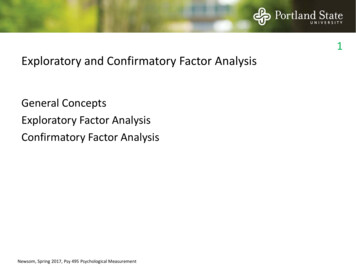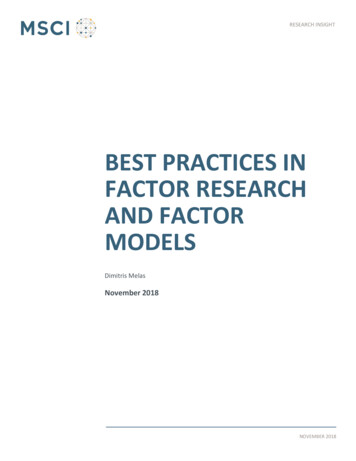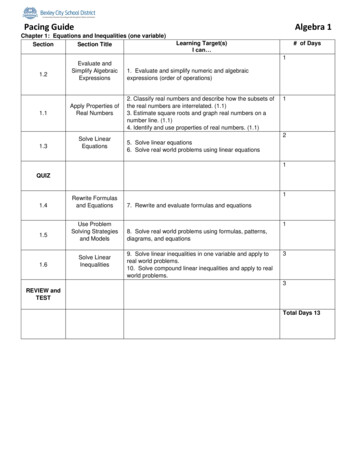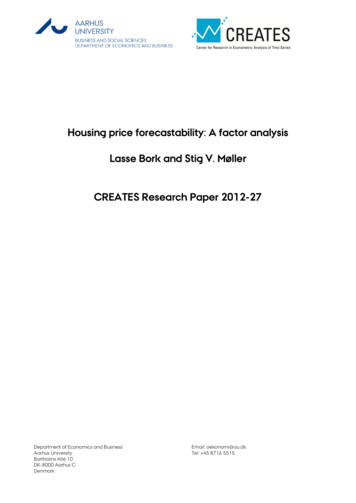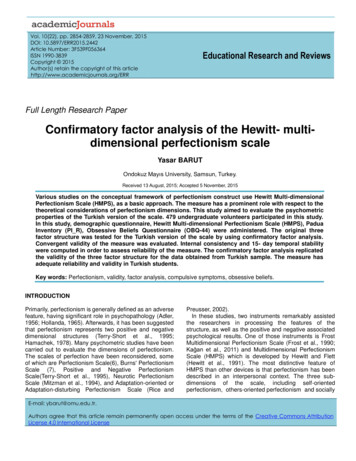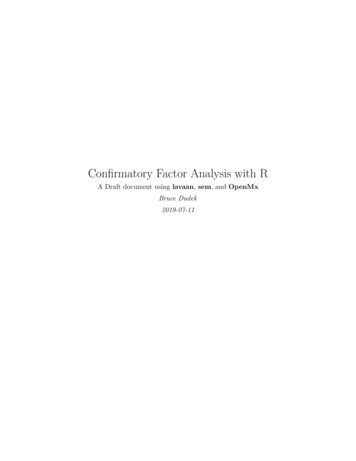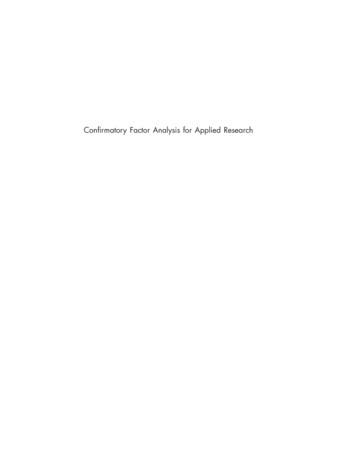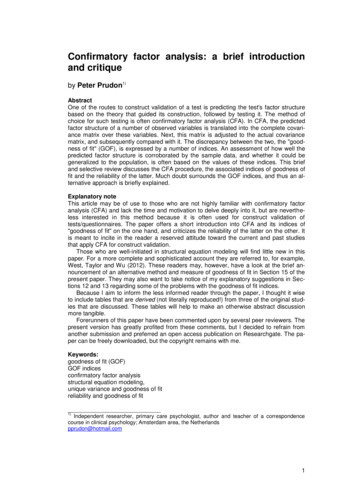
Transcription
Confirmatory factor analysis: a brief introductionand critiqueby Peter Prudon1)AbstractOne of the routes to construct validation of a test is predicting the test's factor structurebased on the theory that guided its construction, followed by testing it. The method ofchoice for such testing is often confirmatory factor analysis (CFA). In CFA, the predictedfactor structure of a number of observed variables is translated into the complete covariance matrix over these variables. Next, this matrix is adjusted to the actual covariancematrix, and subsequently compared with it. The discrepancy between the two, the "goodness of fit" (GOF), is expressed by a number of indices. An assessment of how well thepredicted factor structure is corroborated by the sample data, and whether it could begeneralized to the population, is often based on the values of these indices. This briefand selective review discusses the CFA procedure, the associated indices of goodness offit and the reliability of the latter. Much doubt surrounds the GOF indices, and thus an alternative approach is briefly explained.Explanatory noteThis article may be of use to those who are not highly familiar with confirmatory factoranalysis (CFA) and lack the time and motivation to delve deeply into it, but are nevertheless interested in this method because it is often used for construct validation oftests/questionnaires. The paper offers a short introduction into CFA and its indices of"goodness of fit" on the one hand, and criticizes the reliability of the latter on the other. Itis meant to incite in the reader a reserved attitude toward the current and past studiesthat apply CFA for construct validation.Those who are well-initiated in structural equation modeling will find little new in thispaper. For a more complete and sophisticated account they are referred to, for example,West, Taylor and Wu (2012). These readers may, however, have a look at the brief announcement of an alternative method and measure of goodness of fit in Section 15 of thepresent paper. They may also want to take notice of my explanatory suggestions in Sections 12 and 13 regarding some of the problems with the goodness of fit indices.Because I aim to inform the less informed reader through the paper, I thought it wiseto include tables that are derived (not literally reproduced!) from three of the original studies that are discussed. These tables will help to make an otherwise abstract discussionmore tangible.Forerunners of this paper have been commented upon by several peer reviewers. Thepresent version has greatly profited from these comments, but I decided to refrain fromanother submission and preferred an open access publication on Researchgate. The paper can be freely downloaded, but the copyright remains with me.Keywords:goodness of fit (GOF)GOF indicesconfirmatory factor analysisstructural equation modeling,unique variance and goodness of fitreliability and goodness of fit1)Independent researcher, primary care psychologist, author and teacher of a correspondencecourse in clinical psychology; Amsterdam area, the Netherlandspprudon@hotmail.com1
1. Item clustering as support for construct validationTest scales are devised to measure certain abilities or skills, whereas questionnairescales are devised to measure, for instance, certain personality traits, diagnostic categories and psychological problems. A test item involves a task that calls on the ability or skillto be solved/performed; a questionnaire item represents a psychological phenomenonthat is thought to be an expression of the trait or psychological problem, or to be a featureof the diagnostic category. For that reason, the items within a test or questionnaire scaleare supposed to have at least modest inter-correlations.Thus, the items of a test or questionnaire scale should cluster based on their intercorrelations. If a test or questionnaire is supposed to measure several distinct capacitiesor qualities, then the items should form clusters corresponding to these various subscales. If these capacities or qualities are thought to be inter-related albeit distinct, thenthe subscales should inter-correlate substantially, although not so high that they could aswell be fused. If an item appears to correlate very weakly with the remainder of the scaleitems, then it is either psychometrically poor or it is a mistaken operationalization of theconstruct to be measured. If many of the items happen to inter-correlate weakly, then thetheory that guided the development of the test/questionnaire is most likely erroneous.It follows that an empirically found item clustering that corresponds to the ideas thatguided the construction of the test or questionnaire is strong support for the construct validity of the instrument. If the predicted clustering deviates radically from the empiricallyfound clustering, the theory behind it could be considered refuted. However, if the deviation is moderate, it could be a basis for refinement of the theory and/or further improvement of the measuring instrument. It should be noted that all of these assessments holdprovided a good sample has been drawn.However, how does one test and evaluate the empirical clustering in relation to the apriori cluster prediction?2. Methods for testing a predicted item clusteringA rather indirect approach would be to apply exploratory factor analysis (EFA) to one’sdata and observe whether the indicators of extracted factors - after orthogonal or obliquerotation - correspond to the clusters. The disadvantage of this - formerly often applied approach may be that the empirical factor structure is affected too much by incidentalhigh and low items correlations, yielding factors that differ in number and content from thetest scales. However, this effect does not necessarily indicate a refutation of the prediction. Adjusting the predicted structure to the data without unnecessarily giving up the prediction on the one hand but without violating the data on the other seems a better procedure. How can these aims be achieved?Regarding the number of factors to be drawn, steering in EFA was already shown tobe possible, but steering does not prevent large discrepancies in the composition of thefactors. In the EFA part of the procedure, the factors are rotated such that the factor loadings on the items become optimal. The point of departure hereby is a purely quantitativeone. However, such a rotation could also have as an orientation point the composition ofthe predicted scales. This method is referred to as Procustes rotation (Schönemann,1966; Digman, 1967). It is referred to as such because the empirical factor structure isforced into a predefined factor structure, analogously to what occurred in the GreekProcustes bed myth. The factors are rotated to maximum similarity with the target factormatrix, for instance, by minimizing the sums of squares of deviations from this matrix under the constraint of maintaining orthogonality (as preferred by Schönemann, 1966) or allowing obliqueness (which seems more realistic).An even more direct and controlled way would be to investigate the correlations between the items and the predicted clusters (the latter are mostly operationalized as theunweighted sum of the item scores). These correlations should be in line with the prediction, and even if they are not, they offer a basis for revising the clusters in the direction ofgreater homogeneity and independence. This method is known as (correlative) item analysis and is part of the item response theory approach. If the clusters are indeed revised,the revision must be performed iteratively in a very graduated manner (Stouthard, 2006),2
because after each modification the entire picture of cluster-item correlations will change.Such cluster revision may also be considered a variant of the so-called multiple groupmethod of factor analysis proposed by Tryon (1939), Holzinger (1944), Thurstone (1945,1949) and others. The idea behind this method was to divide the correlation matrix intosections beforehand, instead of extracting orthogonally one factor at a time. (This wassaving much computation time with the calculators of that era, which was the main reason the method was used.) Once such groups of measuring variables have been formed,they can be tested on the basis of the correlation matrix and can be optimized in a number of iterations. The optimized groups are allowed to stand in an oblique relation to eachother - at least initially (Thurstone let it follow by orthogonal rotation) - which is why thetechnique is referred to as the oblique multiple group method (OMG: see Stuive, 2007,12008, 2009) .Tryon (1959) formulated a taxonomy of factor analysis methods, and the method described above he called the abridged rational version of the cumulative communalitymethod of key cluster analysis: rational because pre-clustering is performed based ontheoretical notions; abridged because the diagonal is left vacant instead of containing thecommunalities for each cluster. For the latter reason, Tryon also characterized the method as the poor man’s cluster analysis. The term cluster analysis was perhaps preferredover factor analysis, because the factors were exclusively determined by the most highlycorrelating items, whereas the weakly correlating ones did not contribute at all to the factor, unlike in the case in typical factor analyses. It should be noted that the method concerns the clustering of test items, not of subjects on the basis of similarities.The diagonal need not be left vacant. If it is estimated, the method is referred to as thecommon multiple group method (CMG: Guttman, 1945; Stuive, 2007). Several methodsfor estimating communalities have been proposed, for instance, those of Ten Berge &Kiers (1991) and Gerbing & Hamilton (1994).Although correlative item analysis and OMG appear to be tailored for testing (and revising) cluster predictions, over the last four decades a completely different method hasbecome increasingly preferred: confirmatory factor analysis (CFA). CFA is performed bymeans of programs for structural equation modeling (SEM), e.g., LISREL (Jöreskog,1969). SEM can be used for testing both the measurement and the structural aspects ofthe model. In the first case, SEM is congruent to CFA; the structural aspect is associatedwith a more complicated theoretical model. The output of SEM programs involves, amongother things, a number of measures of goodness of fit (GOF indices) of the model as awhole. These should enable the investigator to evaluate the prediction and to feel confident about generalizing an accepted model from sample to population. It may be this feature that has contributed to the popularity of CFA, next to the fact that it relies on commonfactor analysis, which begins from an estimation of the common variance in items insteadof unweighted item-cluster correlations. Moreover, CFA can accommodate measurementerror.3. CFA and construct validationOne disadvantage of CFA, however, is that secondary factor loadings are not part of theoutput, unlike in the other methods discussed in Section 2. Therefore, it is not possible todetermine whether a certain item would perhaps have been better assigned to anothercluster, especially when its primary factor loading is low. It is not clear to me, as a relativeoutsider, why the secondary factor loadings are not provided by CFA.Instead, so-called modification indices for each item are part of the output. These indices provide an impression of how much the GOF indices would improve if the item wouldbe eliminated from its predicted cluster. However, there is no indication whether the itemsshould be reassigned to another cluster (factor).The absence of secondary factor loadings may imply that the deviation from the prediction becomes less visible; moreover, there are less starting points for suggesting apossible revision of the prediction. That may be the reason that, in a number of cases, the1The characterization "multiple group" is unfortunate, because in CFA it takes on a different meaning.3
investigators content themselves with little more than reporting a few GOF indices for the"winning" and a few rival models, concluding that the model is acceptable or confirmed.They may do so, even if the values of some of the fit indices are mediocre, some of thefactor indicator loadings are clearly too low, and some modification indices indicate thenecessity of modification of the model. Notably, in the case of a newly devised instrument, being psychometrically investigated for the first time, this should not be the path tofollow. The sophistication of SEM programs, in combination with impressive-looking butill-understood fit indices, seems to be an excuse to refrain from critically investigatingsources and the meaning of (remaining) misfit.In addition, how reliable are these indices of goodness of fit in the first place? Therehas been much critical discussion about GOF indices in the specialized literature and ona special discussion website for SEM users (SEMNET). The discussion centers aroundissues such as what values these GOF indices should have to decide between the acceptance and rejection of a model (so-called cut-off values) and how reliable the indicesare. From this discussion, one can learn that the question of reliability and usefulness ofindices of goodness of fit in CFA is far from resolved. For instance, in a special issue ofthe journal Personality and Individual Differences (42, nr. 5, 2007), the difficulties in applying and interpreting GOF indices made Barrett (2007) call for their abandonment: “Iwould recommend banning ALL such indices from ever appearing in any paper as indicative of ‘model acceptability’ or ‘degree of misfit’." (p. 821). Others, however, felt therecould be still a place for them (e.g. Goffin, 2007; Markland, 2007; Mulaik, 2007), whichstill seems to be the point of view among multivariate experts.4. Testing predicted factor structure by means of CFAThe prediction of the factor structure of a test involves the number of factors and thespecification of the test items that define each factor (the so-called indicators), i.e., thoseon which the factor is expected to have high to moderate primary factor loadings. The investigator will most likely also have expectations about the correlation between the factors and perhaps about some of the cross loadings. Measurement error in the observedvariables may be incorporated into the model.To test the predicted factor structure with CFA, the following procedure is used: All of the predicted correlations and error variances (parameters, in the jargon) of thefactor structure are translated "back" into a correlation matrix over all measured variables. This correlation matrix is then adjusted to the empirically found sample correlation matrix by means of some iterative method, mostly maximum likelihood estimation (MLE), insuch a way that the difference between the two is minimized without violating the data.The resulting matrix is the implied correlation matrix. This implied matrix is subsequently compared with the empirical matrix. This comparison results in a residual matrix. Residual matrices are a function of: 1) the approximation discrepancy between themodel values and the hypothetical population values (prediction error) and 2) the estimation discrepancy, which is due to the sample not being completely representative of thepopulation (see Cudeck & Henly, 1991.) The hypothesis is that, on the population level, the approximation discrepancy is zero,so the empirically found difference on the sample level must be only due to the estimationdiscrepancy.2 The difference between the two matrices is expressed in , with degrees of freedom(df) equaling the number of covariances in the matrix minus the number of free parameters (non-predicted parameters, to be freely estimated by the program).2 This should be small enough - in relation to df - to be merely the result of chancedeviations in the sample and not of prediction errors with respect to the population.4
5. Two complications with 2The latter requirement creates a problem: usually expresses the difference between anempirically found distribution and the distribution to be expected based on a null hypothesis. If the difference between the two is sufficiently robust, one can be sure that the peculiarities in the sample distribution are significant, that is, they also hold for the population.However, in CFA the difference should be the opposite of robust; that is, the differenceshould be small enough to accept both the predicted factor structure and its generaliza2tion to the population. Therefore, paradoxically, should be non-significant to indicate asignificant fit.Demanding this may be asking for trouble. Indeed, with large samples, even very2small differences may be deemed significant by current -tables, suggesting a poor fit, inspite of the greater representativeness of a large sample. Many multivariate experts havethought this to be a problem.2An exception to them is Hayduk. He argues that we should profit from 's sensitivityto model error and take the rejection of a model as an invitation for further investigationand improvement of the model (see Hayduk et al., 2007.) On SEMNET, 3 June 2005,2Hayduk notes that “ locates more problems when N is larger, so that some peopleblame chi-square (the messenger) rather than the culprit (probably the model)”.The other side of the coin is that models can never be perfect, as MacCallum (2003)contended, because they are simplifications of reality (see also Rasch, 1980, p. 92).Therefore, models unavoidably contain minor error. In line with this argument, there arealways a few factors in exploratory factor analysis that still contribute to the total explained variance but so little that it makes no sense to take them into account. Thus thesefactors should be ignored in CFA as well. Nevertheless, if the measurements are reliable2and the sample is very large, such minor model error may yield a significant -value, urging the rejection of a model that cannot further be improved.2A further problem with is that its absolute value is not interpretable: it must always2be evaluated with respect to df and N. can be used to determine the statistical significance of an empirically found value (the smallness of the estimation discrepancy), but isnot suited to express the approximation discrepancy. Especially in the case of newly devised instrument a measure for the approximation discrepancy may be desirable. There22fore, some statisticians also report /df, because both and df increase as a function ofthe number of variables (parameters). This quotient is somewhat easier to interpret, butthere is no consensus among SEM experts about what constitutes a desirable value.26. Indices of goodness of fitTo cope with these complications and this problem, SEM experts have tried to deviseother indices of “goodness of fit” or “approximate fit”. These should express the degree ofapproximation plus estimation discrepancy, and provide an additional basis for the ac2ceptance or rejection of a model. All but one of these GOF indices are based on anddf, and some also include N in the formula. The remaining one is based directly on theresiduals. Several suggestions have been made regarding their critical cut-off values (determining acceptance or rejection of a model), among which those of Hu & Bentler (1998,1999) have been very influential.Over the years, these indices have been investigated in numerous studies using empirical data and - more often - simulated data. Time and again they have been shown tobe unsatisfactory in some respect; thus, adapted and new ones have been devised. Now,many of them are available. Only four of them will be mentioned below because they areoften reported in CFA studies and they suffice to make my point. The formulas are derived from Kenny (2012), who - it should be noted - briefly makes several critical remarksin his discussion of the indices:2 RMSEA (root mean square error of approximation): based on , df and N. This indexwas devised by Steiger (1990). Its formula is5
By dividing by df, RMSEA penalizes free parameters. It also rewards a large sample sizebecause N is in the denominator.A value of 0 indicates perfect fit. Hu & Bentler (1998, 1999) suggested .06 as a cutoff value for a good fit. SRMR (standardized root mean square residual: Jöreskog & Sörbom, 1988). To calculate this index, the residuals (Sij - Iij) in the residual correlation matrix are squared andthen summed; this sum is divided by the number of residuals q, which equals p.(p 1)/2,where p is the number of variables, including the diagonal with communalities, and thesquare root of this mean is then drawn. (S denotes sample correlation matrix, and I denotes implied correlation matrix.)A value of 0 indicates perfect fit. Hu & Bentler suggest a cut-off value of .08 for a good2fit. Notice that is not used to calculate SRMR. TLI (Tucker-Lewis index, 1973), also known as NNFI (non-normed fit index), similar tothe next index presented, belongs to the class of comparative fit indices, which are all2based on a comparison of the of the implied matrix with that of a null model (the mosttypical being that all observed variables are uncorrelated). Those indices that do not belong to this class, such as RMSEA and SRMR, are called absolute fit indices. The formulaof TLI is Dividing by df penalizes free parameters to some degree. A value of 1 indicates perfectfit. TLI is called non-normed because it may assume values 0 and 1. Hu & Bentlerproposed .95 as a cut-off value for a good fit.2 CFI (comparative fit index: Bentler, 1990): Here, subtracting df from provides somepenalty for free parameters. The formula for CFI is Values 1 are truncated to 1, and values 0 are raised to 0. Without this “normalization”,this fit-index is that devised by McDonald & Marsh (1990), the RNI (relative non-centralityindex).Hu & Bentler suggested CFI .95 as a cut-off value for a good fit. Marsh, Hau, &Grayson (2005, p. 295) warned that CFI has a slight downward bias, due to the truncationof values greater than 1.0. Kenny (2012) warns that CFI and TLI are artificially increased(suggesting better fit) when the correlations between the variables are generally high.The reason is that the customary null model (all variables are uncorrelated) has a largediscrepancy with the empirical correlation matrix in the case of high correlations between2the variables within the clusters, which will give rise to a much larger than the impliedcorrelation matrix will do. This affects the fractions in CFI and TLI, moving the quotient inthe direction of 1. Rigdon (1996) was the first to raise this argument; later (Rigdon, 1998)he advised using a different null model (all variables an equal correlation above zero).7. Determination of cut-off values by simulation studiesHow do multivariate experts such as Hu & Bentler (1998, 1999) determine what values ofGOF indices represent the boundary between the acceptance and rejection of a model?Experts do so mainly on the basis of simulation studies. In such studies, the investigator6
generates data in agreement with a predefined factor structure, formulates correct andincorrect factor models, draws a great many samples of different sizes and observes whatthe values of a number of fit indices of interest will do.One of the conveniences of simulation studies is that the correct and incorrect modelsare known beforehand, which provides a basis, independently of the fit index values fordetermining whether a predicted model should be rejected or accepted. To express thesuitability of the selected cut-off value of a GOF index, the percentage of rejected samples is reproduced, that is, the samples for which the fit-index value is on the “rejectionside” of the cut-off value. The rejection rate should be very small for correct models, andvery large for incorrect models. What percentage is to be demanded as a basis for recommending a certain cut-off value is often not stated explicitly by many researchers. Itseems reasonable to demand a rate of 10% or even 5% for correct models and atleast 90% or even 95% for incorrect models, considering that mere guessing wouldlead to a rate of 50% and p 05 is conventionally applied in significance testing.A limitation of most simulation studies is that there are very few indicators (e.g., 3 to 6)per factor, compared with the number of items per scale of the typical tests or questionnaires.The study performed by Marsh, Hau & Wen (2004), who replicated the study of Hu &Bentler (1998, 1999), may serve as an example of this method for determining cut-offvalues:.Hu & Bentler had set up a population that corresponded to the following factor structures:three correlated factors with five indicators each, with either 1) no cross-loadings (the “simplemodel” 33 nonzero parameter estimates) or 2) three cross-loadings (the “complex model” 36 nonzero parameter estimates). The misspecification in the simple model involved oneor two factor correlations misspecified (set to zero), and that in the complex model one ortwo cross-loadings misspecified (set to zero).The population of Marsh et al. (2004) involved 500.000 cases. Samples of 150, 250, 500,1000 and 5000 cases were drawn. (The number of samples was not mentioned). MLE wasapplied. The dependent variable was the rejection rate per GOF index with the cut-off valueadvised by Hu & Bentler (1999).2Unlike Hu & Bentler (1999), Marsh et al. (2004) calculated the population values of and the indices.To provide an idea of the results of such studies, a small portion of the tables 1 A and 1Bof Marsh et al. (2004) is reproduced in table 1.Table 1: Cut-off values and related percentage rejection for RMSEA and SRMR (Marsh et al. 2004)Predicted modelsSimple (factor correlations specified) Complex (factor loadings specified)MisspeCut-off cification popul. N 150 N 1000 reject. reject.popul. N 150 N 1000 reject. reject.valuesvalue mean mean N 150 N 1000 valuemean mean N 150 N 1000none.001 .012 .0011%0%.000.012 .0010%0%RMSEAsmallest .046 .042 .04611%0%.068.065 .06767% 99% .06severest .053 .049 .05219%0%.092.088 .091100% 100%noneSRMR .08*)RNI .95 /dfα .052.001.047.0190%0%.001.043.0170%0%smallest .135.144.136100%100%.057.072.06019%0%severest .165.173.165100%100%.070.083.07262%0%1.000 .992none.9991%0%1.000.994.9990%0%smallest .969.966.96818%0%.951.949.95153%39%severest .958.955.95736%2%.910.909.90998%100%none-1.045 1.03014.5% 11.5%-1.047 1.02811.0% 8.0%smallest -1.395 3.39373.5% 100%-1.758 5.87298.5% 100%severest 1.518 4.206 92.0% 100%2.341 9.898 100% 100%popul. value population value (n 500.000); reject. percentage rejected models for this samplesize.*) RNI replaces CFI here; see Section 6.7
Table 1 shows that the mean sample values of the first two fit indices are closer to thepopulation values for N 1000 than those for N 150. This result is observed becausesmaller samples have greater sample fluctuations. It is further demonstrated that thepopulation values (and mean sample values) of RMSEA for the simple model are belowthe advised cut-off values of Hu & Bentler (1999). In line with this observation, the rejection rate for N 1000 is 0%, whereas it should be 100%. For the complex model the population value (and mean sample values if N 1000) of SRMR is below the advised cut-offvalue; thus, the rejection rate is 0% whereas it should be 100%. For RNI (comparablewith CFI), the population values are on the acceptance side of the cut-off values in thetwo misspecified simple models and in the least misspecified complex model, and the re2jection rates are accordingly. Table 1 further shows that, ironically, performs better withrespect to both models simultaneously than the two fit indices, although it leads to aslightly high rate of rejection for the correct models.This replication of Marsh et al. (2004), therefore, does not confirm the advised cut-offvalues of Hu & Bentler (1998, 1999). Several of the misspecified models score on the acceptance side of the cut-off values of the GOF indices. Thus, what should be a cut-offvalue depends, first, on the type of misspecification one is interested in, and secondly, onthe degree of misspecification one is willing to tolerate for each type (Marsh et al., 2004).It can further be concluded from table 1 that smaller samples may be problematicwhen assessing the correctness of a model: the rejection rate for RMSEA in the case ofthe complex model is too low for N 150 (67%), and SRMR shows a systematic samplesize effect - the mean sample value is much above the population value for N 150 (.0832instead of .070). also leads to an insufficient rejection rate in the case of incorrect simple models, at least in the case of the smallest misspecification.Why draw samples?As indicated, Marsh et al. (2004) calculated the population values of the fit indices, andwhen the values appeared to be rather far removed from an advised cut-off value, the rejection rates were close to 0% or 100%, depending on which side of the cut-off valueeach population value was.Chen, Curran, Bollen, Kirby & Paxton (2008) reported similar experiences in their simulation study, which was designed to test the cut-off values for RSMEA. See next Sectionfor more details regarding that study. In table 2 the population values for the three correctand misspecified models are reproduced. Six out of nine population values for the misspecified models were below a cut-off value of .06 or even .05.Table 2: Population values in the study of Chen et al. (2008, derived from table 1)Population values RMSEAMisspecificationModel 1 Model 2 Model 031.084Severest.061.040.097Misspecification overlooking cross-loadings and/or correlations with exogenous variablesThe informatio
become increasingly preferred: confirmatory factor analysis (CFA). CFA is performed by means of programs for structural equation modeling (SEM), e.g., LISREL (Jöreskog, 1969). SEM can be used for testing both the measurement and the structural aspects of the model. In the first case, SEM is congruent to CFA; the structural aspect is associated

